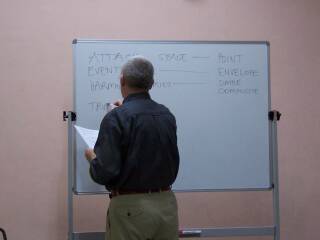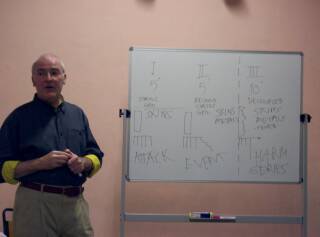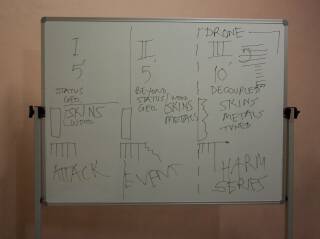


Chris Dench - Status geometry and beyond
reviewed by John Jenkins
Chris Dench, a self-taught composer who came to Australia from the UK in 1989, is creating intricate music with a strong conceptual underpinning. He has had many works performed in Australia and overseas, often by leading new music ensembles and orchestras. Many of his works have been recorded and are available on CD.Interestingly, the actual structure of Dench's talk mirrored that of Beyond Status Geometry, the extended percussion piece he discussed at its climax. Dench began with a discussion of his influences, then looked at his musical ideas, materials and methods. The third and final section of his talk dealt specifically with Beyond Status Geometry.
Dench's influences are now very diverse and include jazz, ethnic musics, and Medieval and Renaissance polyphony. Initially, however, he parted ways from various streams of 'generic modernism'', because the content of new information was relatively low. Why? Because these musical languages were already known, having already solidified into set paradigms and 'given' cultural artefacts.
The elegant Chronomorph by Yuji Takahashi - with sets of pitches derived and structured according to random processes - and some densely 'grainy' pieces by Iannis Xenakis, in which harmonies were sometimes too dense to be audible, first suggested fruitful departures for this composer.
Later, more central influences were the two UK "complexist" composers, Brian Ferneyhough and Michael Finnissy - the former for his intricate, 'nested' and layered compositions, in which the inner structure is so dense it cannot be retraced; and the latter for Finnissy's cantabile effects and overall complex 'strangeness'.
It occurred to Dench in the late 1980s that, when constructing very dense musical clusters, intervals would be filled and become inaudible, to the extent that the entire cluster would begin to coalesce into a single musical event. This insight has also informed his thinking.
Later on, Dench became interested in the player piano pieces by Conlon Nancarrow (scored using a punch and paper roll), in which notes up to 111 per second, disposed in non-standard ratios, became possible - as do complex alignments of parts without vertical integration.
Dench's music seems driven by the necessity of a structural logic following these and other insights, and he feels his percussion pieces are a good point to start, because most untreated percussion instruments have a fixed pitch, which allows much greater focus on pulse and rhythm.
Dench points to models that might be helpful to a greater understanding of his music. Firstly, 'the unravelled labyrinth' – in which a complex structure is teased out, unfolded and exposed. An example of this structural principle was explicated in his flute piece Sulle Scale Della Fenice (1986-9).
Another model is the 'nested labyrinth', in which musically layered events are 'nested', and sometimes concealed, one inside the other. Dench is fond of quoting the writer M. R. James: "He reached the heart of the labyrinth and grasped the jewel."
An example of a 'nested' piece with "interpenetrating musical events", made up of "three separate pieces that simply collided", is his Ruins Within (1992-4), for clarinet.
Other pieces might have a complex inner structure, akin to shifting sonic 'moire' patterns, where rhythms are smoothly subdivided though varying in complex ways, such as in his work for solo piano, Topologies (1979). A similar process occurs in Symphony 4 / Propriocepts (1994-6), which is differently subdivided in different parts of the orchestra, but the parts occur simultaneously.
In his piano piece, Esperance (1986), the two hands play in unusual ratios, such as 14:17 or 14: 10, with rest points between the sections. In Planetesimal Fragments (1992), a choral piece, Dench 'decoupled' two large parts (dividing the choir in two), with the two sets of performers facing away from each other and the parts rhythmically independent, though both groups start and finish at the same time.
In Driftglass (1990), for solo percussion and amplified instruments, Dench was not so much interested in fixed intervals, but in conserving or compressing them, such that the entire 'contour' of the 'sound envelope' rose and fell.
Dench has sometimes employed found instruments, such as bottles and roofing tiles – the world being literally full of materials and objects with percussive possibilities. They are also often modified or extended; for example, by 'bowing' a cymbal or bell with a piece of plastic or violin bow, etc.
The composer's talk ended with Beyond Status Geometry (1994-5), for four percussionists and drone. It is in three parts. In order to discuss this work, Dench used highly idiosyncratic terminology, which he was very careful to define.
'Status rhythm' refers to the familiar and 'given' rhythms with which the modern world is saturated. 'Status geometry' refers to the received and 'given' ways musical events are commonly structured - in ways the composer describes as "very even".
'Attack space' points to the fact that when you strike a percussion instrument you get an instant onset of sound (the attack), at which time begins to be articulated. 'Event space' refers to the entire sound envelope that unfolds after the attack point - where sounds can also be made to change in pitch if the percussion instrument is modified, by using bows or scrapers, etc.
Part 1 of Beyond Status Geometry, mainly for skins and woods, uses the 'attack space' to construct 'status rhythms', with pulses subdivided uniformly. Part 2, for skins, metal and wood, uses 'event space' to construct complex rhythms that are 'beyond status geometry', and become more fragmentary. Part 3 takes us into a full exploration of 'harmonic series', a more complex sound cosmos - into what Dench calls a 'non-psychology'. Each of the three parts is introduced in exactly the same way, with an 'iterative fade-in' of loud drum beats.
Far from wanting to restrict and shackle performers with greater difficulty and complexity, Dench says he wants to accord performers – and for them to accept – a much greater freedom, "to help sculpt the work into something musical." He also wants to seize that elusive jewel in the heart of his labyrinthine sound world – the jewel possibly being the journey to find it.
